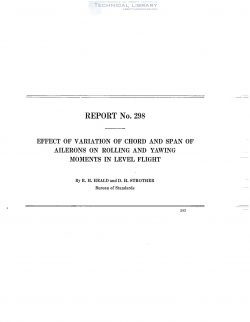naca-report-298

- Version
- 178 Downloads
- 1.28 MB File Size
- 1 File Count
- August 25, 2016 Create Date
- August 25, 2016 Last Updated
National Advisory Committee for Aeronautics, Report - Effect of Variation of Chord and Span of Ailerons on Rolling and Yawing Moments in Level Flight

This report presents the results of an investigation of the rolling and gaming moments due to
ailerons of various chords and spans on two airfoils having the Clark Yand U. S. A. 27 wing sections.
Some attention is deroted to a study of the eject of scale on rolling and yawing moments and to the
efiect of slightly rounding the wing tips.
The results apply to lerel flight with. the wing chord set at an angle of attack of +4° and to
conditions of zero pitch, zero yaw, and zero roll of the airplane. It is planned later to extend the
investigation to other attitudes for monoplane and biplane combinations.
The investigation was undertaken for the Aeronautics Branch of the Department of Com-
merce in cooperation with the National Advisory Committee for Aeronautics for thepurpose of
making available to the industry data relative to the rolling and yawing moments due to con-
ventional ailerons on some representative American wing sections. But little systematic work
has been done along this line, the outstanding contributions being those of Archer (Reference 1)
and Irving, Ower, and Hankins (Reference 2).
The air is drawn through the 10—foot wind tunnel by means of a four-blade 14-foot tractor
propeller driven by a 200-HP. direct-current motor. The lower and upper limits of the speeds
available are, respectively, 20 feet per second and 100 feet per second. A calibration of the
tunnel for speed distribution, Which was made in the area subsequently occupied by the model,
showed the speed to be uniform Within i1 per cent.
The wing models, 60 inches span and 10 inches chord, shown in Figures 2 and 3, were con-
structed oi %-inch mahogany strips and on completion showed a maximum deviation from the
templates of :5: 0.02 inch. The metal templates were constructed accurately to the dimensions
of. the two sections as given in N. A. C. A. Technical Report No. 233. It was felt that this
deviation was permissible in wooden models of this size. Two models of each wing were pre-
pared, in order to permit tests in biplane combination.
| File | Action |
|---|---|
| naca-report-298 Effect of Variation of Chord and Span of Ailerons on Rolling and Yawing Moments in Level Flight.pdf | Download |

Comment On This Post